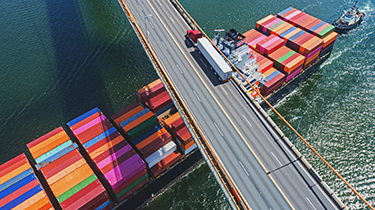Each year EDC Economics publishes its views of the top risks facing Canadian exporters over the next 12-18 months. While protecting your business from all risk is neither possible nor even desirable, planning around those risks that are most plausible and impactful can help fine-tune your risk management systems and better position you for success.
A year ago, we were grappling with the economic and geopolitical fallout from the war in Ukraine, including global food insecurity and the widely disruptive energy crunch. While still very much on the radar, the predominance of these risks has diminished, as Canadian exporters adapt to the enduring impacts of the conflict. In our most recent Trade Confidence Index (TCI), only 30% of respondents still identified those challenges as impediments to their business. Additionally, while food security remains front and centre for many food importers, the United Nations Food and Agriculture Organization Food Price Index is down 25% since last year. That said, any escalation of the conflict would certainly change the calculation here.
Instead, the biggest risks facing Canadian exporters largely stem from the soft patch confronting the global economy, as it seeks to put the distortions caused by the COVID-19 pandemic firmly in the rearview. The dramatic increase in central bank policy rates over the past year and a half, together with associated financial market stresses, will reduce the flow of credit into the system over the next several quarters. It could even bring about a deep global recession, especially if lenders tighten their lending standards even further in response. According to our calculations, this could lead to a permanent loss of between 1% and 2% of global economic output.
While not our base case, such a scenario could also expose those households and businesses that over-extended themselves during the last decade of excessively “cheap money.” As interest rates and bond yields trend higher and post-pandemic liquidity is reduced, borrowers will experience credit pressures, increasing the risk of a wave of corporate defaults. While some of this may be part of a healthy correction, the adjustment could nevertheless prove messy.
You should also check out
EDC Economics identifies the challenges facing Canadian companies, including recession fears, war in Ukraine and food insecurity.
Government debt has also ballooned in recent years, as fiscal authorities helped cushion the blow of the pandemic, keep up with rising health-care costs, boost defence spending in response to geopolitical uncertainty and confront new challenges, like climate change. This increases the risk around a spate of a sovereign debt crises. We’ve already seen a number of protracted debt re-negotiations for countries at heightened risk of debt distress, putting many low-income markets on the cusp of default.
The resulting swings in asset prices could also have potentially dangerous knock-on effects across the banking system. As witnessed in March, with the highly publicized failure of a number of U.S. banks, any loss of confidence or release of animal spirits increases the risk of deposit flight, threatening to turn a local banking crisis into a global one.
While some risks are more cyclical in nature, others may be part of more broad-based secular trends. One of these is concern around the unwinding of globalization. While our base case doesn’t envision a material upending of the global trade paradigm, the risk of geopolitical fragmentation should be considered. Specifically, the increasingly antagonistic posture of the world’s major trading blocs has already instigated reciprocal retaliations around critical industrial technologies. Canada’s own trade and investment links in fast-growing regions of the world could also be impacted by such a shift.
Closely linked is the risk of supply chain disruptions and labour constraints. While supply chain pressures have eased significantly over the past year, falling well below pre-pandemic levels, recent events have reminded us of the fragility of the globalized production networks on which we depend. Labour constraints also remain an ongoing concern for many Canadian companies, with almost 90% of TCI respondents reporting issues in accessing skilled labour.
The bottom line?
Economic and geopolitical risks appear to have become more pervasive and interdependent than ever before. While some of the risks identified here are cyclical in nature, and subject to the inevitable fluctuations of any recovery period, others may have a more enduring and transformative impact. But, whatever the case, Canadian exporters should take account of the balance of risks and opportunities that lie ahead in order to best position themselves for success.
This week, special thanks to Ian Tobman, manager of our Economic and Political Intelligence Centre.
As always, at EDC Economics, we value your feedback. If you have ideas for topics that you would like us to explore, please email us at economics@edc.ca and we’ll do our best to cover them.
This commentary is presented for informational purposes only. It’s not intended to be a comprehensive or detailed statement on any subject and no representations or warranties, express or implied, are made as to its accuracy, timeliness or completeness. Nothing in this commentary is intended to provide financial, legal, accounting or tax advice nor should it be relied upon. EDC nor the author is liable whatsoever for any loss or damage caused by, or resulting from, any use of or any inaccuracies, errors or omissions in the information provided.







